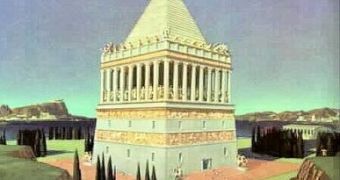He was one of the greatest military leaders of the Antiquity: he defeated the Persian Empire and created the largest empire of the ancient world in 13 years only. Alexander the Great had a tomb matching his personality in the city he founded at the mouth of the Nile River in 331 BC: Alexandria.
For almost 600 years, his tomb was a pilgrimage place for people coming from all over the world. At the beginning of the 4th century AD, its tomb disappeared both as monument and from the written texts.
The great Alexander died of malaria in the palace of the Persian kings in Babylon, on 10th of June 323 BC. His body was embalmed and placed in a sarcophagus of massive gold, filled with spices and perfumes. Hid death triggered a battle for power amongst his generals, each one attempting to take possession of his remains, as soon after the death of the great leader, because they were considered to have magical virtues. Between Babylon, Egypt and Macedonia, the last variant was chosen, but this destination was found thousands of kilometers away, and a special vehicle had to be built for this purpose.
The funerary hearse was finished in 2 years, but the result was indeed rather a temple on wheels than a transport car. The columns and the throne were built of gold and the roof was plated with scales made of gemstones. In the middle of the mobile temple, the catafalque with Alexander's body was covered by a purple shroud woven with gold. The huge hearse was towed by 64 mules.
But both the suite and the hearse did not reach Macedonia. On the way, between Babylon and Palestine, Ptolemy I, an ex-general of Alexander, who had become king of Egypt, embezzled the coffin. By detaining the remains of Alexander, Ptolemy considered himself his rightful heir and his possession of Egypt was thus not contested by anyone. Taking advantage of the fact that the Egyptian priests considered Alexander a god, Ptolemy wanted to bury him close to the pyramids of Memphis, the religious capital of Egypt.
Several years later, once his power was consolidated, Ptolemy afforded to move Alexander's remains to Alexandria, which he had turned into his capital. Here, Ptolemy raised a magnificent mausoleum hosting the coffin. To the end of the 3rd century BC, Ptolemy IV would place Alexander's remains together with those of his ancestors, to remind the people that he had descended directly from Alexander's lineage.
Nobody knew how the new mausoleum looked like. It is said that Ptolemy X (110-88 BC) even melted the gold of the coffin, because of the lack of money, replacing it with a glass one. But pilgrims still came from huge distances. Greek historians Diodorus Siculus and Strabo said that Julius Caesar and Octavian Augustus visited the remains of Alexander.
By the 4th century, the location of Alexander's tomb was lost. The oblivion lasted until the 19th century, when the Egyptian astronomer Mahmud el-Falaki attempted to locate the tomb. But he took in consideration some three centuries old Arab writings and considered the tomb could be located under the mosque of prophet Daniel, where he was not allowed to dig.
Searches made during the 20th century failed to discover the tomb. The general opinion is that the tomb could be located in the Latin Cemeteries, somewhere between the ancient Via Canopica (rediscovered by el-Falaki) and Via R1, in the modern city of Alexandria.

 14 DAY TRIAL //
14 DAY TRIAL //